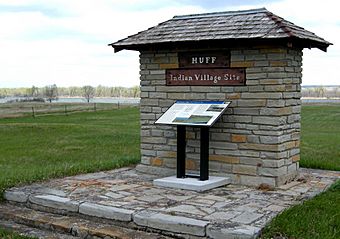Huff Archeological Site facts for kids
|
Huff Archeological Site
|
|
 |
|
| Lua error in Module:Location_map at line 420: attempt to index field 'wikibase' (a nil value). | |
| Nearest city | Huff, North Dakota |
|---|---|
| NRHP reference No. | 80002920 |
Quick facts for kids Significant dates |
|
| Added to NRHP | July 23, 1980 |
| Designated NHL | February 18, 1997 |
The Huff Archeological Site is a very old Mandan village in North Dakota. It was built around the year 1450 AD. People found this special place in the early 1900s. Today, it is known as a National Historic Landmark. This means it's a really important historical site. It is also one of the best-preserved villages from that time period.
Where is the Huff Village?
This ancient village is found near the town of Huff. It sits right on the bank of the Missouri River in Morton County, North Dakota.
In the 1960s, people working at the site got help from the US Army Corps of Engineers. They worked to make the river bank strong. This helped protect the village from the river. Because of this, most of the old village is still untouched.
You can still see the shape of the village on the ground today. It was built in a rectangle. It once had many houses and strong walls around it. A long ditch, about 2,000 feet (610 meters) long, still goes around three sides of the village. The village covers about 12 acres of land next to the river.
Life in the Ancient Village
The Huff village was lived in about 200 years before Europeans came to the area. The people who lived here were farmers. They also hunted large animals like bison.
It seems like these villagers had to deal with fighting. Their home was very well protected. It had deep ditches and strong lookout points called bastions. Most of the buildings inside the walls were shaped like rectangles. They were dug into the ground about one or two feet deep. The posts that held up their roofs were made from trees nearby. All the doorways of these homes faced southwest, away from the river.
There was one house that was a bit different. It was more square with rounded corners. The way the village was set up is like other Mandan villages. It had a main open area in the middle, called a plaza. There was also a special building for ceremonies that opened into this plaza.
Visiting the Site Today
Today, the Huff Archeological Site is protected. The State Historical Society of North Dakota takes care of it. It is now called the Huff Indian Village State Historic Site.
You can take a walking tour there. There are signs that tell you all about the village and its history. The Mandan people, whose ancestors lived here, now live on the Fort Berthold Reservation in North Dakota. This site is a very important part of North Dakota's history. It also helps us understand the rich heritage of Native Americans.

